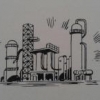Latest Downloads
-
 Water Bath Indirect Heaters
Water Bath Indirect HeatersArt Montemayor - Oct 12 2018 02:35 PM
-
 Petroleum: A Primer for Kansas
Petroleum: A Primer for KansasArt Montemayor - Oct 12 2018 02:27 PM
-
 Spray Tower for Flue Gas Scrubbing Design
Spray Tower for Flue Gas Scrubbing Designankur2061 - May 02 2018 02:31 PM
-
 Selection of Vertical Tanks
Selection of Vertical Tanksankur2061 - Apr 19 2018 07:42 AM
-
 Pressure Drop Calculator for Strainers 1
Pressure Drop Calculator for Strainers 1ankur2061 - Mar 24 2017 02:04 PM
-
 Horizontal Pig Trap System Design Guidelines
Horizontal Pig Trap System Design Guidelinesankur2061 - Jan 14 2017 02:54 PM
-
 Performance Prediction of 3-Stage Propane Refrigeration System
Performance Prediction of 3-Stage Propane Refrigeration Systemankur2061 - Aug 08 2016 02:43 PM
-
 Centrifugal Pump Troubleshooting Checklist
Centrifugal Pump Troubleshooting Checklistankur2061 - Dec 17 2015 08:18 AM
-
 Compressor Troubleshooting Checklist
Compressor Troubleshooting Checklistankur2061 - Sep 08 2015 11:43 AM
-
 Amine Sweetening Unit Preliminary Design
Amine Sweetening Unit Preliminary Designankur2061 - May 19 2015 09:35 AM
Popular Store Titles
 Tank Jacket Calculator
Tank Jacket Calculator
 Specification Sheet Collection
Specification Sheet Collection
 PIPESIZE
PIPESIZE
 Relief Valve Sizing
Relief Valve Sizing
 Rupture Disc Sizing
Rupture Disc Sizing
Chemical and Process Engineering Resources
Submitted Chris Haslego, Nov 21 2011 11:21 AM | Last updated Nov 21 2011 01:29 PM
| Category: | Process Control |
| Question: | What would be the best option for limiting or eliminating ethanol vapor emissions from storage tanks at ambient conditions? |
| Keywords: | v1i1,ethanol,emissions,limiting,storage,tank,reflux,condenser,vent |
| Answer: | BACKGROUNDOften times, ethanol plants are equipped with very old external storage tanks that contain my relief devices. Emissions from such tanks are being targeted to limit ethanol entering the atmosphere.ANSWERSeveral options exist:1. The easy and "process-smart" answer to tankage emissions is pressurized storage; for ethanol, conventional API tank design standards allow for 2.5 psig design and this is more than ample for containing the vapors within the tank at most ranges of ambient temperatures. However, this may be a major stumbling point in your industry. The existing tanks may be very old and without calcs to put any basis on. I would strongly recommend you upgrade (as soon as you have the economic or process justification) to stainless material and a 2.5 psig design. This will make life a lot better for everyone involved. However, this may not be an immediate option ?Ǫ?Ǫ2. Try to get your existing tanks rated for pressurized service. Of course you need conservation vents on them, for tank protection. Rating them may be easier said than done. You may have already looked at this and discovered the futility of dealing with old, workable tanks. But this is an option nonetheless3. Consider cooling the incoming ethanol with the coldest water you have available and store at that temperature. This lowers the storage vapor pressure and reduces the emissions. This doesn?ÇÖt stop the emissions; it just reduces them. This was probably the most obvious option that may have already been explored. The point here is that it is more cost effective to cool a liquid than to partially condense a saturated vapor. The disadvantage here is that you must conserve the cool liquid temperature if your ambient is appreciably higher. This calls for insulation and more maintenance.4. You might be able to ?Ç£control?Ç¥ the ethanol emissions by venting through a small, continuous water scrubber and concentrating the aqueous ethanol to a level where you can recycle it back to process. This may or may not be feasible or cost effective.5. The least attractive option, in my opinion, is putting an atmospheric vent condenser on the existing atmospheric tanks and cooling-condensing the emissions (like a ?Ç£kick-back?Ç¥ condenser) with a refrigerant or brine. This method requires relatively expensive refrigeration equipment and controls --- with additional maintenance on equipment. Economic evaluation of this method usually shows little or no return.Source: CERP Message Board, Mr. Art Montemayor |
Forum Quick Links
Tech Q & A Category List
-
 Bulk Solids
Bulk Solids
-
 ChE Outside the Plant
ChE Outside the Plant
-
 Chemical Process Business
Chemical Process Business
-
 Chemistry Basics
Chemistry Basics
-
 Corrosion
Corrosion
-
 Equipment Design
Equipment Design
-
 Experimentation and Testing
Experimentation and Testing
-
 Fluid Dynamics
Fluid Dynamics
-
 Heat Transfer Technology
Heat Transfer Technology
-
 Industrial Utilities
Industrial Utilities
-
 Mass Transfer
Mass Transfer
-
 Physical Property Information
Physical Property Information
-
 Plant Basics
Plant Basics
-
 Plant Economics
Plant Economics
-
 Preparing to Become an Engineer
Preparing to Become an Engineer
-
 Process Control
Process Control
-
 Reactions and Processes
Reactions and Processes
-
 Refining
Refining
-
 Safety
Safety
-
 Separation Technology
Separation Technology
-
 The Environment
The Environment
-
 Thermodynamics
Thermodynamics

 FB
FB



0 Comments